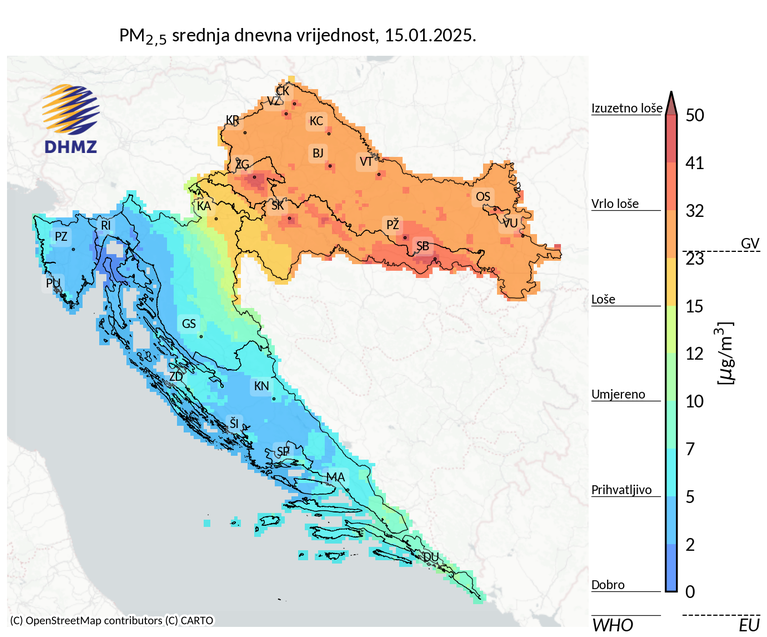January the 16th, 2025 – A three-day Croatian air quality forecast are now available as a new type of forecast through the State Hydrometeorological Institute (DHMZ).
As Poslovni Dnevnik writes, the three-day Croatian air quality forecast is now available to all on the website of the State Hydrometeorological Institute (DHMZ). This brand new DHMZ product provides practical information on air quality for the current and next two days and enables people to better plan outdoor activities. In addition, they can now make more informed decisions regarding their own health and the health of their loved ones.
The new Croatian air quality forecast predicts concentrations of four key pollutants that significantly affect human health. These are primarily suspended particles with a diameter of less than 2.5 and 10 micrometers (μm), better known as PM2.5 and PM10, followed by nitrogen dioxide (NO2) and ground-level ozone (O3).
By selecting a pollutant for a specific day, a map of Croatia is displayed with the distribution of concentrations within clearly marked boundaries of zones and agglomerations. Air quality levels are shown on a colour scale and range from Good to Extremely Poor. Each predicted level is linked to appropriate health recommendations issued by the World Health Organisation (WHO). The Croatian air quality forecast will be updated daily.
a special adaptation for the croatian air quality forecast
The three-day Croatian air quality forecast is the result of the ATMOSYS (LIFE+) air modelling system, specially adapted for Croatia through a European Union structural project called AIRQ.
a significant step for the protection of human health
This step represents the concrete expansion and modernisation of the national network for continuous air quality monitoring. The air quality level for each pollutant is determined based on the forecasted concentrations for any given day, for which the average daily (24-hour) concentration for PM2.5, PM10 and NO2 and the maximum daily eight-hour value for O3 are calculated.
Air quality levels are determined by values from zero (0) to ten (10), as follows: Good – 0, Acceptable – 2, Moderate – 4, Poor – 6, Very poor – 8 and Extremely poor – 10 and are linked to the health recommendations of the World Health Organisation (WHO). These guidelines refer to the general populous as well as for more vulnerable groups of people, such as children and adults with respiratory or cardiac problems. The recommendations are based on scientific research on the impact of air pollution levels on human health.
This initiative represents an important step in protecting the health of the general public, meeting EU standards, and strengthening transparency through open and timely access to air quality data. People can use the three-day Croatian air quality forecast to supplement data on measured pollutant concentrations. This data is available in near real-time on the Air Quality in Croatia portal, which is under the jurisdiction of the Ministry of Environmental Protection and Green Transition, as well as on the website of the Ministry of Environmental Protection and Green Transition.
strengthening ourselves against environmental pollutants
The Director General of the Croatian Meteorological and Hydrological Service, Dr. Ivan Güttler, emphasised that the new Croatian air quality forecast means improving the entire system.
“Along with meteorological and hydrological forecasts, this is the third area of the Croatian Meteorological and Hydrological Service’s forecasting activities. I’m very grateful to the Croatian Meteorological and Hydrological Service team that established the ATMOSYS system as one of the AIRQ project activities. Once again, the importance of EU and national funds in financing the activities needed to strengthen the resilience of communities to various environmental problems has been demonstrated, this time in the area of air quality,” Güttler stated.
Jadranka Škevin – Sović, Head of the Air Quality Sector of DHMZ and Project Manager of the AIRQ project, recalled that air quality forecasting is one of the key results of the project Expansion and Modernisation of the National Network for Continuous Air Quality Monitoring – AIRQ. It was completed back in September 2023. The project was financed by EU funds in the amount of 85%, while the remaining 15% was provided through national funds and funds from the Environmental Protection and Energy Efficiency Fund.
“Given the increasingly serious problems related to pollution, numerous studies conducted around the world have shown that air pollution forecasting is of the utmost importance. By establishing an air quality modelling system and developing a model for estimating ground-level concentrations of pollutants, more effective air quality control is enabled. This facilitates decision-making, and the expected results include a reduction in the number of illnesses and premature deaths caused by air pollution, as well as a reduction in medical and other related costs,” concluded Škevin-Sović.











